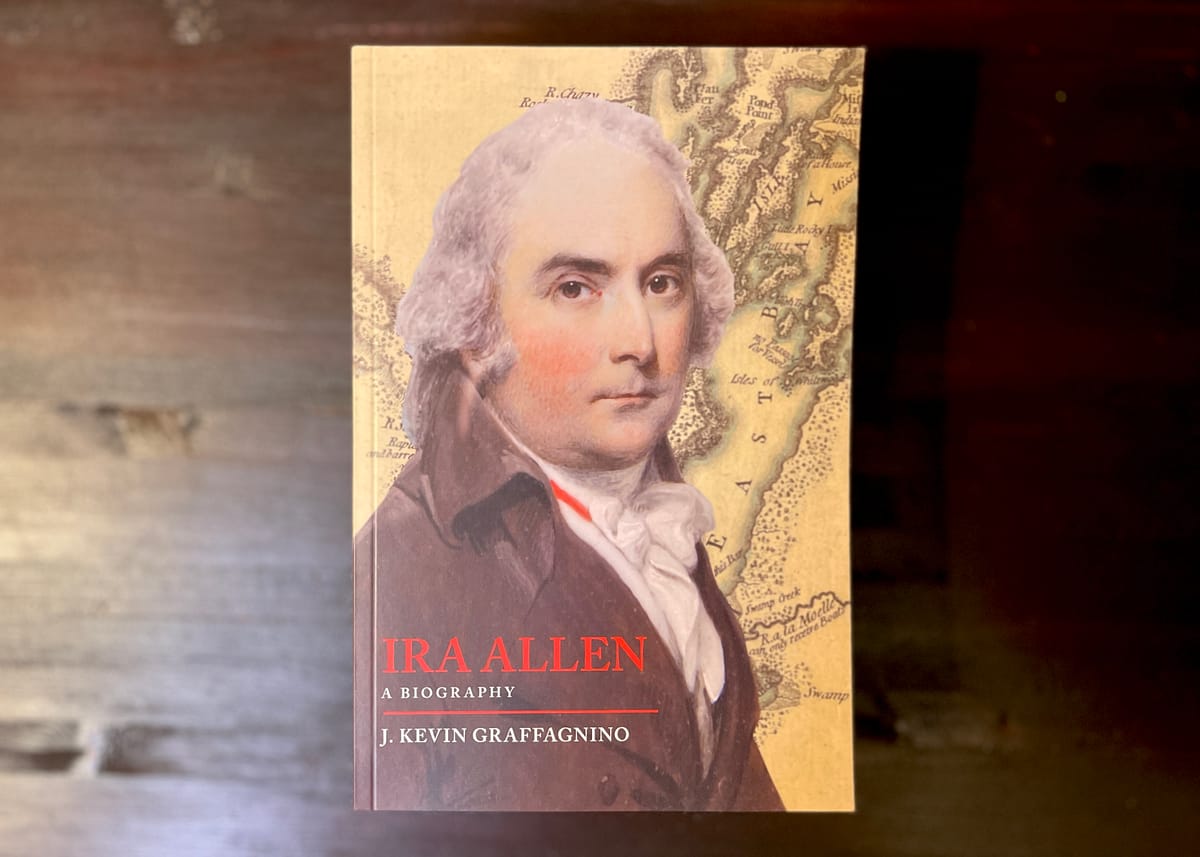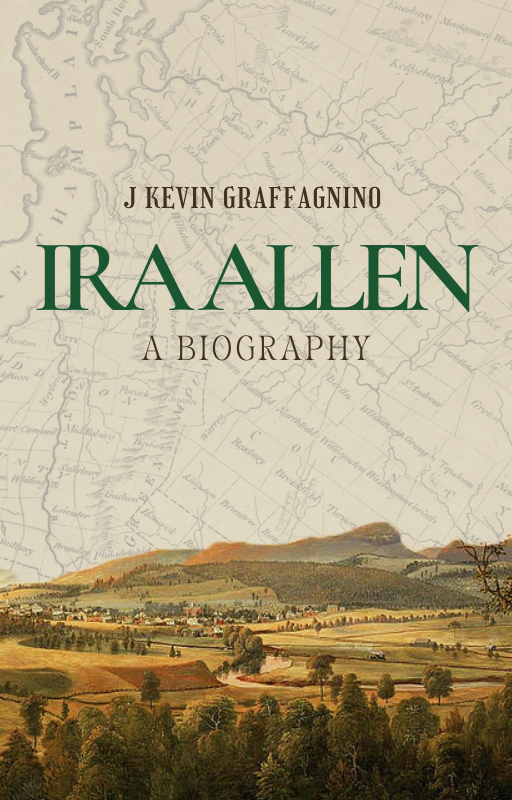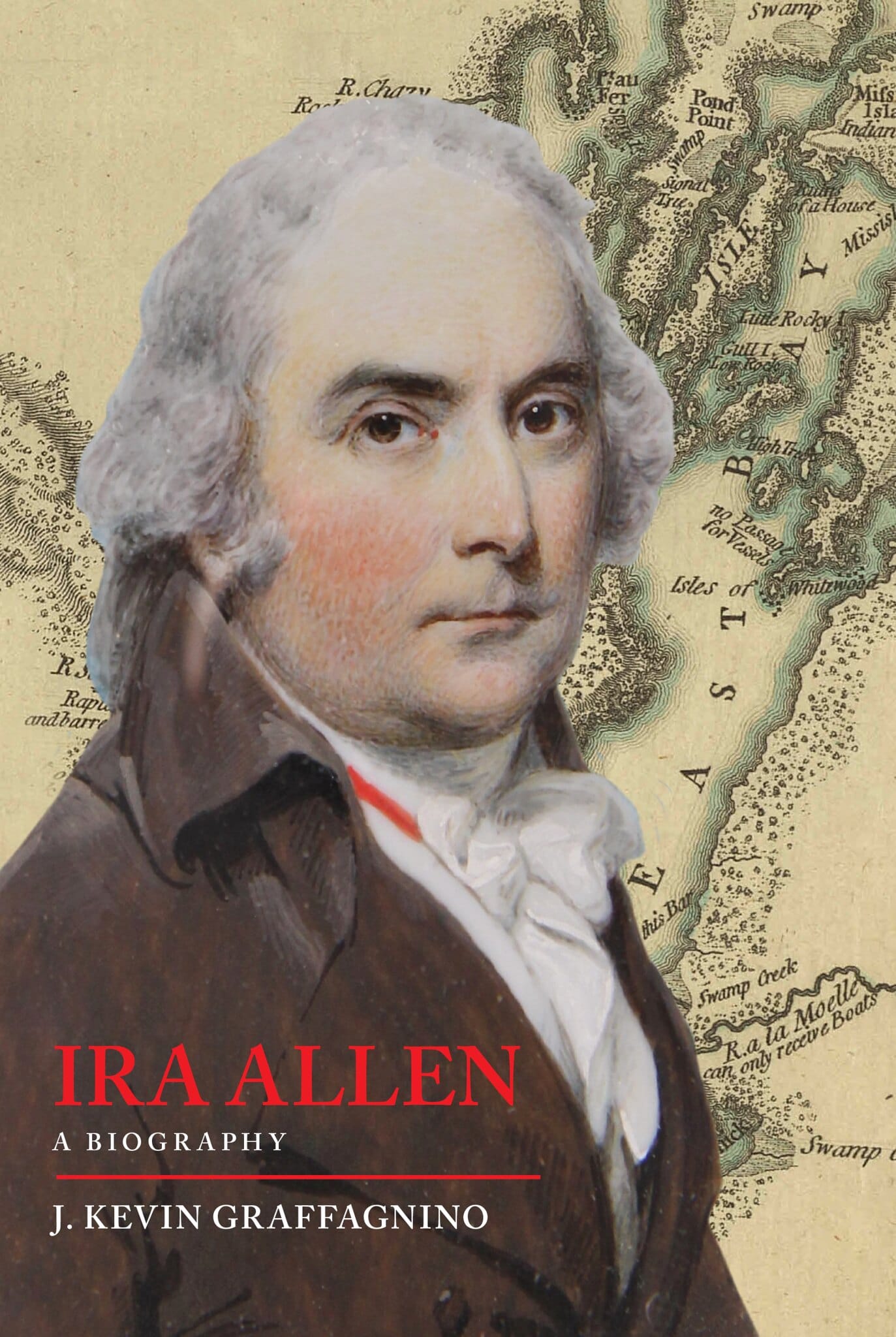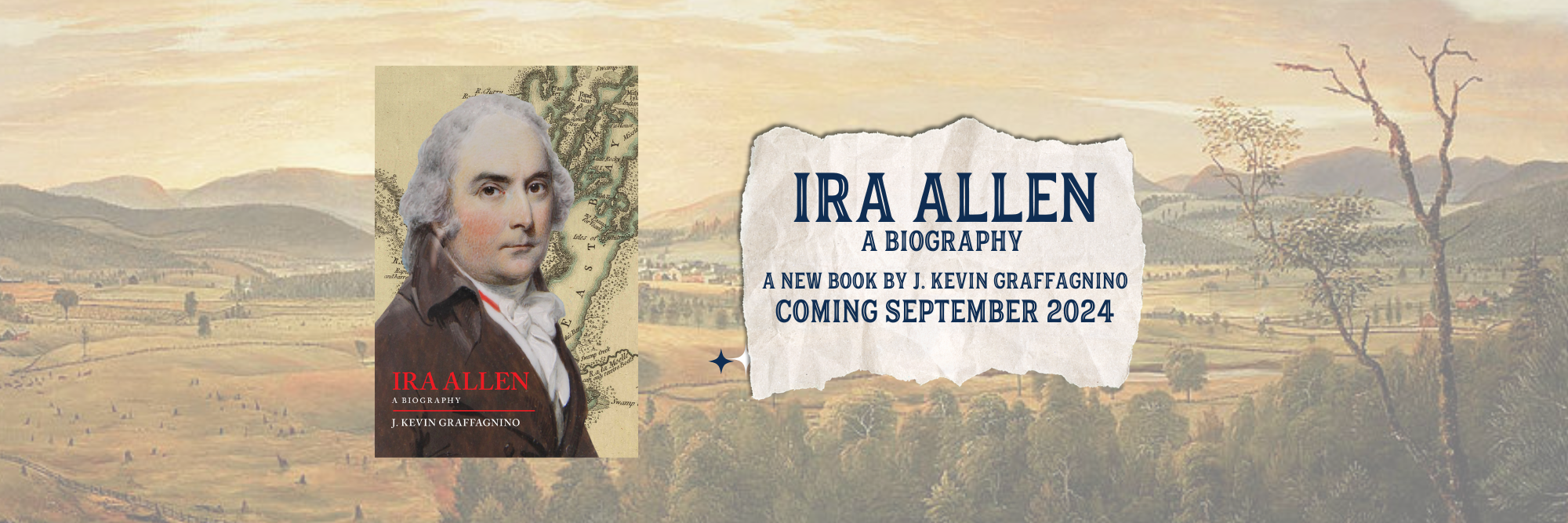Paper grinder
A look into marketing and selling a history book

One of the things that I like to do is write about books, and in my day job at the Vermont Historical Society, I've found myself operating in a very small part of the publishing industry. A lot of people are surprised to learn that we publish books. We do, with a specific focus: books about Vermont's history.
A friend of mine told me about the job in 2021 or early 2022: my formal title is PR & Guest Services Coordinator, which means that I do everything from managing our social media to running our bookstore at the museum in Montpelier. Part of that, as it turns out, has been promoting our line of books, both to the media, reading public, and bookstores, and I've found it to be an interesting process. I'm not involved in the editorial or commissioning process (don't send me manuscripts, go here for that), but once a book is in the pipeline, that's when I get to work.

Our latest book is Ira Allen: A Biography by J. Kevin Graffagnino, and it's been in the works for a little while. Graffagnino, our former executive director, actually wrote this as his PhD dissertation back in the 1990s, and after bouncing around from archives and historical societies around the country, he returned to Vermont when he retired, and the ball started rolling to clean up the manuscript for publication. It came to us, and after our publishing committee looked it over, it went into the pipeline.

They didn't have to do much for this particular title: new copy edits and some updates, but for other books, we've helped guide the research and writing process, as in our 2023 book, "Vermont for the Vermonters": The History of Eugenics in the Green Mountain State by Mercedes de Guardiola. Once it gets to the publishable stage, we started working on the next phase: printing and selling it, which is where I get involved.
I think about book covers and book art a lot on this newsletter, and some of that thinking has percolated into my work here: in my role as PR goblin for VHS, it's a book that will sit on the bookshelves of not only our museum, but our website, bookstores around the state, libraries, and book sales. We can talk about Ira Allen's story and his importance to the state's history, but how do we get people to pick it up and investigate further? The cover plays a big role here.
One of the fun parts of this project has been playing more of a role in the cover design here. The eugenics book was a challenge to put together in 2023: we didn't want to use people or specific locations. I played with a bunch of ideas, but de Guardiola had the best idea, to use a stylized family tree map, which I think worked pretty well.
For this book, I wanted to do something a little different. I've found some of our prior covers a bit wanting: some are better than others, and I wanted something straightforward. Last winter, I took a quiet afternoon and started browsing through covers of other biographies of figures from this era, which essentially boiled down to a portrait of the book's subject against a plain-ish background. I then took some of the same elements and put them together in Canva for an image that we could point our designer, Jim Brisson, to.

I've been following a book designer on Instagram, Elisha Zepeda, who's been posting progress images of some of the covers he's worked on, which I found helpful and enlightening. It prompted me to try a slightly different approach:

I didn't end up submitting that version, as we were already pretty far along in the process, but it was a useful exercise to break down a cover into smaller elements and try and convey the story that way. This one is missing a big part: Allen himself, but I'm thinking this style might make for a good starting point for another project.
My original version ended up being a good model for what we ended up with. Those versions were just hacked together with some random maps that I snagged for the background, so we selected a better version, commissioned a better scan of Allen's portrait from UVM, and ended up liking the red typeface a bit better than the yellow-orange that I selected (which I think works better with black and white anyway.)

Once we locked the cover in, the look and tone of the cover helped to inform how we'd go about marketing the book on our website and social media. Zepeda put together a nifty book cover template that sets book covers against a plain background, which I've borrowed and used for our other titles. (see the header image above.)
And once all of that was done, we actually need the book itself. Brisson handled the interior text design and layout, our editor handled lining up things like the ISBN number, details for the Library of Congress, index, ebook files, lined up blurbs, and things like that. I wrote the marketing copy, sent copies out to reviewers around the state, lined up press coverage, social media and store assets, added the product entry on our storefront and on Amazon, and began getting the word out, first to newsletter subscribers, then to press, libraries, and bookstores.

For this book, I put together a marketing plan, one that covered how we'd roll out the announcement of the book, press outlets to contact, what we'd put out in newsletters, and when we'd open up preorders. The book was supposed to hit stores back in April to tie in with Ira Allen's birthday, but we had some production delays and opted to bump it to the fall, out of the way of some of our big exhibits and projects over the summer.
This was something that I did for the eugenics book, and it was interesting to see how these two projects set out to accomplish the same goals, but were different in tone. Eugenics is a somewhat controversial and painful topic, one that's still relevant in Vermont's communities: there are still some survivors of the practice out there, and it's a book that has some pretty clear parallels to the mental health crisis that the state is facing and trying to work with right now. It's a timely book, and something that we could use while pitching the book and its story to news outlets and other writers.
Ira Allen: A Biography is completely different. It's more of what I'd call a "Dad History": the sort of book that you might buy you father or father-in-law, but which isn't necessarily tied to social issues in the present day. (Our next book will go back to the pressing social story: a history of Vermont's COVID-19 response by historian and journalist Garrett Graff, part of a big oral history project we stood up in 2022.)
There are lots of biographies of old white guys out there, and while it's not quite as newsworthy, Graffagnino put together a book that's compelling and interesting. Ira Allen isn't as well known as his older brother Ethan, and played a much larger role in the formation of Vermont as an independent republic and eventually, the 14th state in the Union. Even better, Ira was a pretty reviled figure in his day: he played an important role in the creation of the state, but died penniless, exiled from Vermont and was buried in an unmarked grave somewhere near Philadelphia. As Graffagnino notes in the introduction of his book, Ira's passing was barely mentioned in Vermont press at the time. There's a compelling story in the rise and fall of a person, and as Graffagnino noted in a couple of interviews, his subject was a hard person to admire.
Here in Vermont, Ethan Allen is often lionized as a founding father of Vermont, although his role was just part of the puzzle. (I highly recommend Christopher Wren's Those Turbulent Sons of Freedom: Ethan Allen's Green Mountain Boys and the American Revolution to learn more about Ethan and his complications), Ira is less well-known to the public, so part of the marketing challenge has been to teach folks who he was, pushing his story out through some of our partnerships and publications. This isn't exactly what I'd call "hidden history," but there's a lot of curiosity in learning about these individuals and events that haven't had quite as much time in the spotlight.
Additionally, the semisesquicentennial (250 years) anniversary of the founding of the United States is coming in 2026. You'll see a lot about this in the next couple of years as that big milestone approaches, and there'll be a lot of work done to examine and reexamine the founding of the nation and the people who helped make it happen. Ken Burns has one of his huge documentaries coming out to mark the occasion, and there'll be plenty of other things along the way. Ira Allen was an important figure in this corner of the country, and one of the ways that I've been thinking about this book is how it's a good, accessible window into not just his life, but the formation of Vermont during this period. It also pairs nicely with some of our other books about this time period, such as Elise Guyette's Discovering Black Vermont: African American Farmers in Hinesburg, 1790-1890, Harvey Amani Whitfield's The Problem of Slavery in Early Vermont, 1777-1810, Neil Goodwin's We Go As Captives: The Royalton Raid and the Shadow War on the Revolutionary Frontier, Robert Mello's Moses Robinson and the Founding of Vermont, and John J. Duffy, H. Nicholas Meuller III, and Gary Shattuck's The Rebel and the Tory: Ethan Allen, Philip Skene, and the Dawn of Vermont. Hopefully, it'll be a book that folks will gravitate towards as that celebration approaches.
That's a central part of how I go about doing my job: not just as someone to put together information about VHS and our programming and publications, but using social media, outreach, and the internet as ways to further our mission to educate Vermonters and "Vermonters at heart"; using everything from a social media post to talk about the history of our state, all the way up to publications.
Above all, it helps that this is a good read. We're an academic organization, and some of our books are a little more on the academic side. Not impossible to read, but they might be a bit limited in appeal to a broader audience. While this has its roots in a PhD dissertation, Graffagnino wrote it as a narrative, and I found it to be an engaging story about Allen and his life. I've enjoyed reading it, and I'm looking forward to seeing what other readers think of it as they dig into it this fall.
A big chunk of my time over the last couple of months has been selling the book. When I came into this role in 2022, we didn't seem to do much on the sales front. We had released a bunch over the years, and would fill requests as they came in, but there didn't seem to be a ton of outreach. With the eugenics book out in 2023, I put together a list of bookstores in the state, put together a catalog of our titles, and began getting in contact to let them know about what we had to offer. It's been a fun project, especially as I've worked in bookstores and libraries in the past, and it's taught me some interesting lessons in being persistent and figuring out how I need to go beyond "here's a new book that we have." This year, I was pleased when a couple of bookstores that I'd been trying to get our books into finally got back in touch and placed orders for the first time.
We also sell books directly to readers, and I had to keep track of the preorders as they started rolling in. That brought its own set of additional things: did we have enough mailers and postage on hand? Where do we put these piles of books while we wait for them to sell? And with a handful of titles that are similar to this one, like The Rebel and the Tory and Moses Robinson and the Founding of Vermont, do we have enough copies on hand in case people want to learn more about our history?
This week has been a blur, starting on Saturday when I had Graffagnino stop by the museum to sign preordered copies, to Tuesday and Wednesday as I packed and shipped those preorders, delivered books to bookstores or the post office, and shared the articles and reviews of the book that have been popping up online. And starting today, I've got Graffagnino stopping by the museum for an impromptu talk and signing, after which point he'll be going around the state to talk about his work and his subject. We'll be into the holiday sales season by that point, at which time we'll be doing another round of sales for bookstores and readers, we'll probably start experimenting with some ads for the book, and whatever talks and follow up articles we'll have for some of our publications and programming. Our next issue of History Connections will likely be themed around the American Revolution to tie in with the kickoff of the 250th, and I've already told Graffagnino that we'll tap him for a brief article.
And then, we'll shift focus to our next book, which we're supposed to release in the spring, and the entire process will start all over again. Whew.
All of this is to say that publishing a book is a lot of work. Publishers accomplish this on a much larger scale and with a much larger staff, but even in this slimmed down version, there's a lot hiding under the surface that just isn't visible to the readers at the end of the pipeline. As a writer, I find it useful and interesting to know about some of those smaller details, like the ISBN number, or the number of iterations and conversations that we had about the cover. Just about every book that you see on a bookstore shelf goes through something like this: not just the writing of the manuscript, but a whole constellation of decisions that comes long after the author has completed the text.